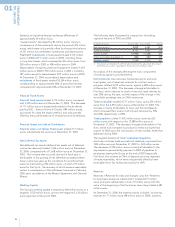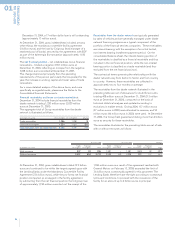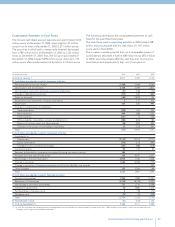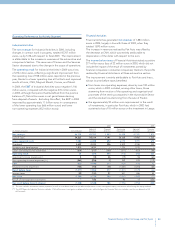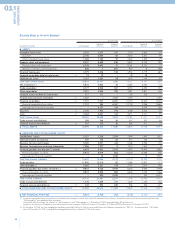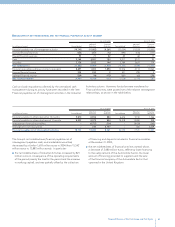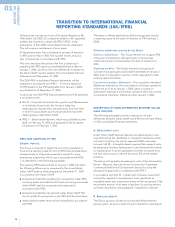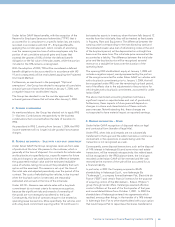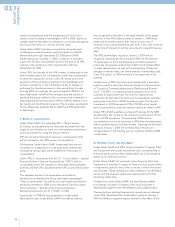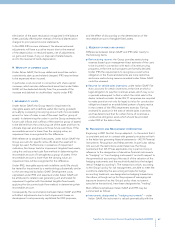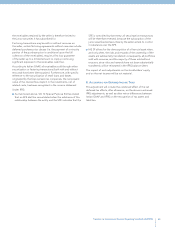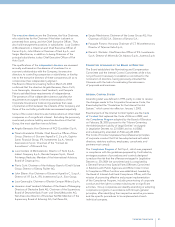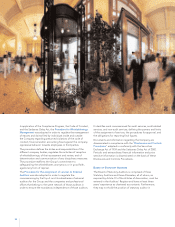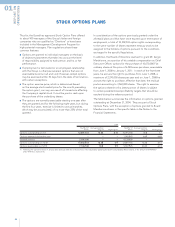Chrysler 2004 Annual Report Download - page 46
Download and view the complete annual report
Please find page 46 of the 2004 Chrysler annual report below. You can navigate through the pages in the report by either clicking on the pages listed below, or by using the keyword search tool below to find specific information within the annual report.
REPORT ON
OPERATIONS
01
44
TRANSITION TO INTERNATIONAL FINANCIAL
REPORTING STANDARDS (IAS/IFRS)
Following the coming into force of European Regulation No.
1606 dated July 2002, EU companies traded on EU regulated
markets are required to adopt IAS/IFRS (“IFRS”) in the
preparation of their 2005 consolidated financial statements.
This will require a restatement of prior years.
At the present date, Fiat is finalizing its process of transition
to IFRS and will report 2005 First Quarter results and prior
year comparatives in accordance with IFRS.
This note describes the policies that Fiat is adopting in
preparing the IFRS opening consolidated balance sheet at
January 1, 2004, as well as the main differences in relation to
the Italian GAAP used to prepare the consolidated financial
statements until December 31, 2004.
The 2004 IFRS consolidated financial statements will be
prepared in accordance with IFRS 1 – First-time Adoption
of IFRS based on the IFRS applicable from January 1, 2005,
as published as of December 31, 2004.
In particular, the 2004 IFRS financial statements will be prepared
in accordance with:
■IAS 39 – Financial Instruments: Recognition and Measurement
in its entirety. In particular, the Group is adopting
derecognition requirements retrospectively from the date
in which financial assets and financial liabilities had been
derecognized under Italian GAAP.
■IFRS 2 – Share-based Payment, which was published by the
IASB on February 19, 2004 and adopted by the European
Commission on February 7, 2005.
FIRST-TIME ADOPTION OF IFRS
GENERAL PRINCIPLE
The Group is required to apply the accounting standards in
force at the reporting date for its first IFRS financial statements
retrospectively to all periods presented, except for some
exemptions adopted by the Group in accordance with IFRS
1, as described in the following paragraph.
The opening IFRS balance sheet at January 1, 2004 will reflect
the following differences as compared to the consolidated
Italian GAAP balance sheet prepared at December 31, 2003
in accordance with Italian GAAP:
■all assets and liabilities qualifying for recognition under IFRS,
including assets and liabilities that were not recognized under
Italian GAAP, shall be recognized and measured in
accordance with IFRS;
■all assets and liabilities recognized under Italian GAAP that
do not qualify for recognition under IFRS shall be eliminated;
■certain balance sheet items will be reclassified in accordance
with IFRS.
The impact of these adjustments shall be recognized directly
in opening equity at the date of transition to IFRS (January 1,
2004).
OPTIONAL EXEMPTIONS ADOPTED BY THE GROUP
Business combinations – The Group elected not to apply IFRS
3Business Combinations retrospectively to the business
combinations that occurred before the date of transition to
IFRS.
Employee benefits – The Group elected to recognize all
cumulative actuarial gains and losses that existed at January 1,
2004, even if it decided to use the corridor approach for later
actuarial gains and losses.
Cumulative translation differences – The cumulative translation
differences arising from the consolidation of foreign operations
will be set at nil as at January 1, 2004; gains or losses on
subsequent disposal of any foreign operation shall only include
accumulated translation differences after January 1, 2004.
DESCRIPTION OF MAIN DIFFERENCES BETWEEN ITALIAN
GAAP AND IFRS
The following paragraph provide a description of main
differences between Italian GAAP and IFRS that will have effects
on Fiat consolidated financial statements.
A. DEVELOPMENT COSTS
Under Italian GAAP applied research and development costs
may alternatively be capitalized or charged to operations when
incurred. Fiat Group has mainly expensed R&D costs when
incurred. IAS 38 – Intangible Assets requires that research costs
be expensed, whereas development costs that meet the criteria
for capitalization must be capitalized and then amortized from
the start of production over the economic life of the related
products.
The Group will capitalize development costs of the Automobile,
Ferrari – Maserati, Agricultural and Construction Equipment,
Commercial Vehicle and Components Sectors by using the
retrospective approach in compliance with IFRS 1.
In accordance with IAS 36 – Impairment of Assets, impairment
tests will be applied to development costs capitalized as
intangible assets and impairment losses will be recognized if the
recoverable amount of an asset is less than its carrying amount,
as further described in the paragraph “Impairment of assets”.
B. EMPLOYEE BENEFITS
The Group sponsors funded and unfunded defined benefit
pension plans, as well as other long term benefits to employees.


